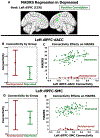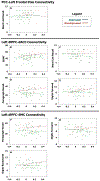Intrinsic Functional Network Connectivity Is Associated With Clinical Symptoms and Cognition in Late-Life Depression
- PMID: 30392844
- PMCID: PMC6368882
- DOI: 10.1016/j.bpsc.2018.09.003
Intrinsic Functional Network Connectivity Is Associated With Clinical Symptoms and Cognition in Late-Life Depression
Abstract
Background: Late-life depression (LLD) has been associated with alterations in intrinsic functional networks, best characterized in the default mode network (DMN), cognitive control network (CCN), and salience network. However, these findings often derive from small samples, and it is not well understood how network findings relate to clinical and cognitive symptomatology.
Methods: We studied 100 older adults (n = 79 with LLD, n = 21 nondepressed) and collected resting-state functional magnetic resonance imaging, clinical measures of depression, and performance on cognitive tests. We selected canonical network regions for each intrinsic functional network (DMN, CCN, and salience network) as seeds in seed-to-voxel analysis. We compared connectivity between the depressed and nondepressed groups and correlated connectivity with depression severity among depressed subjects. We then investigated whether the observed connectivity findings were associated with greater severity of common neuropsychiatric symptoms or poorer cognitive performance.
Results: LLD was characterized by decreased DMN connectivity to the frontal pole, a CCN region (Wald χ21 = 22.33, p < .001). No significant group differences in connectivity were found for the CCN or salience network. However, in the LLD group, increased CCN connectivity was associated with increased depression severity (Wald χ21 > 20.14, p < .001), greater anhedonia (Wald χ21 = 7.02, p = .008) and fatigue (Wald χ21 = 6.31, p = .012), and poorer performance on tests of episodic memory (Wald χ21 > 4.65, p < .031), executive function (Wald χ21 = 7.18, p = .007), and working memory (Wald χ21 > 4.29, p < .038).
Conclusions: LLD is characterized by differences in DMN connectivity, while CCN connectivity is associated with LLD symptomology, including poorer performance in several cognitive domains.
Keywords: Aging; Cognition; Cognitive control network; Default mode network; Functional connectivity; Geriatric.
Published by Elsevier Inc.
Conflict of interest statement
The authors report no biomedical financial interests or potential conflicts of interest.
Figures




Similar articles
-
Intrinsic inter-network brain dysfunction correlates with symptom dimensions in late-life depression.J Psychiatr Res. 2017 Apr;87:71-80. doi: 10.1016/j.jpsychires.2016.12.011. Epub 2016 Dec 12. J Psychiatr Res. 2017. PMID: 28017917 Free PMC article.
-
Altered functional interaction hub between affective network and cognitive control network in patients with major depressive disorder.Behav Brain Res. 2016 Feb 1;298(Pt B):301-9. doi: 10.1016/j.bbr.2015.10.040. Epub 2015 Oct 28. Behav Brain Res. 2016. PMID: 26519557
-
Disrupted intrinsic functional connectivity of the cognitive control network underlies disease severity and executive dysfunction in first-episode, treatment-naive adolescent depression.J Affect Disord. 2020 Mar 1;264:455-463. doi: 10.1016/j.jad.2019.11.076. Epub 2019 Nov 13. J Affect Disord. 2020. PMID: 31780136
-
Resting state brain network function in major depression - Depression symptomatology, antidepressant treatment effects, future research.J Psychiatr Res. 2017 Sep;92:147-159. doi: 10.1016/j.jpsychires.2017.04.007. Epub 2017 Apr 24. J Psychiatr Res. 2017. PMID: 28458140 Review.
-
Dysregulation within the salience network and default mode network in hyperthyroid patients: a follow-up resting-state functional MRI study.Brain Imaging Behav. 2020 Feb;14(1):30-41. doi: 10.1007/s11682-018-9961-6. Brain Imaging Behav. 2020. PMID: 30259292 Review.
Cited by
-
A digital intervention targeting cognitive control network dysfunction in middle age and older adults with major depression.Transl Psychiatry. 2021 May 4;11(1):269. doi: 10.1038/s41398-021-01386-8. Transl Psychiatry. 2021. PMID: 33947831 Free PMC article.
-
Low Functional network integrity in cognitively unimpaired and MCI subjects with depressive symptoms: results from a multi-center fMRI study.Transl Psychiatry. 2024 Apr 5;14(1):179. doi: 10.1038/s41398-024-02891-2. Transl Psychiatry. 2024. PMID: 38580625 Free PMC article.
-
Preliminary Evidence That Cortical Amyloid Burden Predicts Poor Response to Antidepressant Medication Treatment in Cognitively Intact Individuals With Late-Life Depression.Am J Geriatr Psychiatry. 2021 May;29(5):448-457. doi: 10.1016/j.jagp.2020.09.019. Epub 2020 Sep 28. Am J Geriatr Psychiatry. 2021. PMID: 33032927 Free PMC article. Clinical Trial.
-
Recent advances in the use of imaging in psychiatry: functional magnetic resonance imaging of large-scale brain networks in late-life depression.F1000Res. 2019 Aug 6;8:F1000 Faculty Rev-1366. doi: 10.12688/f1000research.17399.1. eCollection 2019. F1000Res. 2019. PMID: 31448089 Free PMC article. Review.
-
Abnormalities in the default mode network in late-life depression: A study of resting-state fMRI.Int J Clin Health Psychol. 2022 Sep-Dec;22(3):100317. doi: 10.1016/j.ijchp.2022.100317. Epub 2022 May 27. Int J Clin Health Psychol. 2022. PMID: 35662792 Free PMC article.
References
-
- Taylor WD (2014): Depression in the Elderly. N Engl J Med 371: 1228–1236. - PubMed
-
- Tadayonnejad R, Ajilore O (2014): Brain network dysfunction in late-life depression: a literature review. J Geriatr Psychiatry Neurol 27: 5–12. - PubMed
-
- Mulders PC, van Eijndhoven PF, Schene AH, Beckmann CF, Tendolkar I (2015): Resting-state functional connectivity in major depressive disorder: A review. Neurosci Biobehav Rev 56: 330–344. - PubMed
Publication types
MeSH terms
Grants and funding
LinkOut - more resources
Full Text Sources
Other Literature Sources

